Chapter: Civil : Railway Airport Harbour Engineering : Railway Engineering : Railway Stations and Yards
Classification of Railway Stations
Classification of
Railway Stations
Railway stations can broadly be sorted into various classes on
the basis of two main considerations.
Operational
considerations
As per the general and subsidiary rules of Indian Railways
stations are classified as block stations and non-block stations. Block
stations are further classified as A class, B class, and C class stations.
Non-block stations are classified as D class or flag stations.
Functional
considerations
Stations
are classified based on the functions they are required to perform. Under this
category, stations are classified as halt stations, flag stations, crossing
stations or wayside stations, junction stations, and terminal stations.
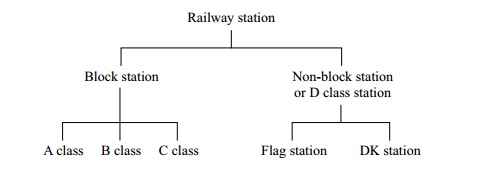
The
following factors are taken into consideration when classifying a railway
station.
(a) Least
expenditure with regard to the provision of the least number of signals
(b) Flexibility
in shunting operations
(c) Increasing
the line capacity
(d) Faster
movement of trains
1 Block Stations
A block station is a station at
which the driver has to obtain an 'authority to proceed' in order to enter the
next block section. In a railway system that is inclusive of block stations,
the entire railway line is divided into convenient block sections of 5 to 10 km
and a block station is provided at the end of each block. This system ensures
that a suitable 'space interval' is provided between running trains so that
there are no collisions and accidents. There are three types of block stations.
A class station
A class stations are normally
provided on double-line sections. At such stations a 'line clear' signal cannot
be granted at the rear of a station unless the line on which a train is to be
received is clear and the facing points set and locked. No shunting can be done
after line clear has been granted.
A class
stations are suitable for sections where traffic passes rapidly. It is
essential for the driver of the train to have an advance knowledge of the
layout of the block station. The typical layout of an A class station with
two-aspect signalling is shown in Fig. 26.1.
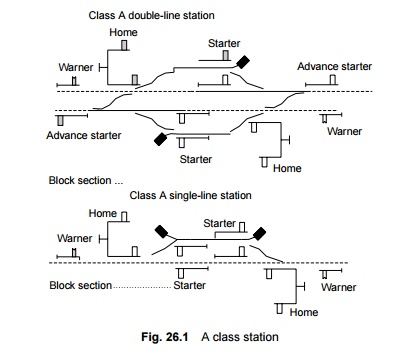
The signals required at an A class station are as follows.
Warner A warner
signal is placed at a warning distance from the home signal, the main
function of which is to indicate whether the section beyond is clear or
otherwise.
Home A home
signal, which is the first stop signal.
Starter A starter
signal is placed at an adequate distance from the home signal and marks
the point up to which the line should be clear so that the train can be given
permission to approach.
Advance starter This
signal is optional and is provided to allow the drivers to further
increase the speed of the trains.
Advantages
(a) More
economical vis-à-vis B class stations because of the use of fewer signals.
(b) Ensures
the safety of the train because of the provision a warner signal ahead of a
home signal.
(c) Trains
normally stop within the station limits.
Disadvantages
(a) No
shunting is possible once line clear has been granted.
(b) Another
clear disadvantage of A class stations, is that a line at the station has to be
kept clear up to the starter signal once the line clear signal has been given,
and as such the flexibility of working and shunting is restricted.
B class station
This is
the most common type of station and is provided on single-line as well as
double-line sections. At a B class station (Fig. 26.2), the line has to be
clear up to an adequate distance beyond the outer signal before 'permission to
approach' can be given to a train. The minimum signals required at a B class
station are as follows.
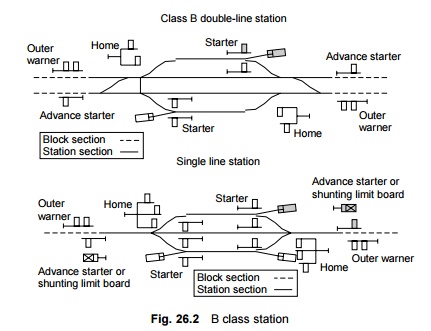
Outer An outer
signal, which is the first stop signal. The outer signal can also be below
the warner also.
Home A home
signal, which protects the facing point and is placed at an adequate distance
from the outer signal.
Starter A starter
signal is also provided on a double-line section.
The B class station is the most
common station in use on Indian Railways because it offers greater flexibility
of working. By providing a warner on the outer arm post, this station can also
cater to fast traffic while permitting shunting of vehicles even when a clear
signal has been given.
C class station
The C
class station (Fig. 26.3) is only a block hut where no booking of passengers is
done. It is basically provided to split a long block section so that the
interval between successive trains is reduced. No train normally stops at these
stations. The minimum signals required are as follows.
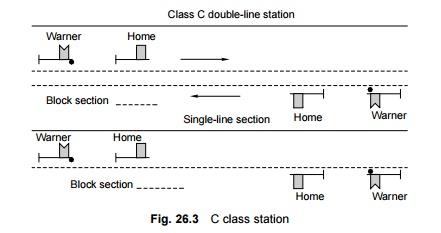
Warner A warner
signal placed at an adequate warning distance from the home signal
to indicate whether the section ahead is clear or not.
Home A home
signal, which is the first stop signal.
The advantage of a C class
station is that it ensures the faster movement of trains and increases line
capacity. The disadvantage, however, is that no shunting is possible and trains
cannot stop at these stations.
2 Non-block Stations or D Class Stations
D class or non-block stations are
located between two block stations and do not form the boundary of any block
section. No signals are provided at D class stations.
A D class
station that serves an outlying siding is called a DK station. At such a
station, the siding takes off through a crossover, which can be operated only
with the help of a key, which in turn is released with the help of a ball
token. A D class station that serves no siding is called a flag station.
3 Functional Classification of Stations
The layout of stations varies in
size and importance according to the type and volume of traffic handled and
according to their locations with respect to cities or industrial areas.
Broadly speaking, the layouts required for passenger stations and their yards
can be divided into the following categories for the purpose of study.
(a) Halts
(b) Flag
stations
(c) Roadside
or crossing stations
(d) Junction
stations
(e) Terminal
stations
Halt
A halt
(Fig. 26.4) is the simplest station where trains can stop on a railway line. A
halt usually has only a rail level platform with a name board at either end.
Sometimes a small waiting shed is also provided, which also serves as a booking
office. There is no yard or station building or staff provided for such types
of stations. Some selected trains are allotted a stoppage line of a minute or
two at such stations to enable passengers to entrain or detrain. The booking of
passengers is done by travelling ticket examiners or booking clerks. A notable
example of the halt is a Gurhmukteshwar bridge halt, which is situated on the
bank or river Ganga.

Flag station
A flag station (Fig. 26.5) is
more important as a stop-over for trains than a halt and is provided with a
station building and staff. On controlled sections, a flag station is equipped
with either a Morse telegraph or a control phone, which is connected to one of
the stations on either side to facilitate easy communication. A flag station is
usually provided with a small waiting hall and booking office, platforms and
benches, and arrangements for drinking water. Sometimes a flag station is also
provided with a siding for stabling wagons booked for that station.
Wayside or crossing station
After a
flag station comes the wayside or crossing station. While a flag station has
arrangements for dealing with traffic but none for controlling the movement of
the trains, a crossing station has arrangements for controlling the movement of
trains on block sections. The idea of a crossing station was initially
conceived for single-line sections, to facilitate the crossing of trains going
in opposite directions so that there may be a more rapid movement of trains.
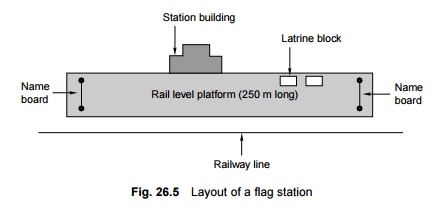
Crossing stations may be further classified as (a)
Roadside small- and medium-sized stations and (b) Major stations. Some of the
important tasks dealt with these stations are the following.
Operating work The main
operations performed at these stations include attending to the passing
and crossing of trains, giving precedence to important trains, and other
miscellaneous works done for stopping passenger trains. Slow passenger trains
mostly stop at small stations whereas mail and express trains stop at major
stations.
Goods traffic These
stations mostly deal with parcel traffic only. Piecemeal wagon load
goods traffic is now being accepted on roadside stations as per the new policy
of the Railway Ministry with effect from December 1994.
Operation of points and signals The
operation of points and signals is controlled either by a central
cabin or two cabins at either end of the station.
Reception and dispatch of trains The
reception and dispatch as well as shunting of trains is handled
as per the instructions laid down in the 'station working order'. Block
instruments are provided either in the station master's office or in the cabin,
but the entire responsibility of carrying out these operations lies with the
station master.
Station master's duty for run-through trains When a
train runs through the station, the station master should stand
opposite his office in proper uniform and exchange 'all right' signals with the
driver and guard of the train. He should watch the running train carefully and
if there are any unusual occurrences such as the incidence of a hot box, he
should instruct the station officials in advance to stop and examine the train.
Wayside or crossing station on a
single-line section Increasing traffic on a single-line section
necessitates the construction of a three-line station, which provides an
additional line as well as more facilities for passing traffic. A typical
layout of a three line station providing one additional line and simultaneous
reception facilities is given in Fig. 26.6. It may be possible to improve the
facilities further by introducing an additional line to deal with goods
traffic.
The
following are some of the important features of this track layout.

(a) It is a
three-line station and provides facilities for the simultaneous reception of
trains from both sides because of the proximity of sand humps in each
direction.
(b) There are
two platforms, namely, an island platform and a platform near the station building.
The island platform can deal with two stopping trains simultaneously. Also, if
a goods train has to be stopped at an island station, it can be accommodated on
the loop line of the platform, thus keeping the main line free for run-through
traffic. Important trains can be made to halt on the platform near the station
building.
(c) There is
a dead end siding at either end of the station to accommodate wagons that are
marked sick.
(d) The foot
over bridge (FOB) helps the passengers to reach the island platform from the
station building and vice versa.
Double-line crossing station with
an extra loop In the case of a double-line section, which
consists of separate up and down lines to deal with traffic moving in either
direction, the layout of a station yard is somewhat different.
Figure
26.7 shows a double-line station with three lines receiving, with one common
loop for trains coming from both sides. Some of the important features of this
layout are as follows.
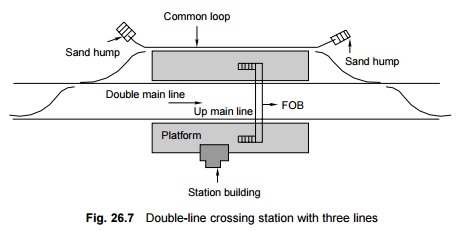
(a) This is a
wayside station for a double-line section with almost minimum facilities.
(b) In
addition to two main lines an up line and a down line, there is a common loop
that can receive trains from either direction. There is a total of three lines
only.
(c) It
consists of two platforms, one an island platform and the other a platform
beside the station building.
(d) There is
a foot over bridge to connect the station building to the island platform and
back.
(e) There are
emergency crossovers provided on either side of the station so that it can be
converted into a single-line station in the case of an emergency.
Double-line
crossing station with four lines The more common layout of a
station yard on a double-line section has four lines station as shown in
Fig. 26.8. The important features of this layout are as follows.
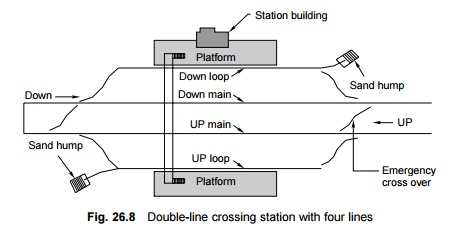
(a) This is a
four-line station, where, apart from two up and down main lines, there are two
extra loops. These loops are directional loops, i.e., one is known as a down
loop as it is meant for down trains while the other is an up loop and is meant
for up trains.
(b) There are
two platforms provided with connection loops. One of these platforms can also
be an island platform.
(c) There is
provision of a foot over bridge to connect the two platforms.
(d) Two
emergency crossovers are provided on either side of the station so that is can
be converted into a single-line station in the case of an emergency.
Junction stations
A junction station is the meeting
point of three or more lines emerging from different directions. Normally at
junctions, trains arrive on branch lines and return to the same station from
where they started or proceed to other stations from where they again return to
their originating stations.
The
typical layout of a junction station with a single main line and a single
branch line is shown in Fig. 26.9. The important features of junction stations
are as follows.

(a) There are
two platforms-one is the main line platform and the other is an island
platform. In case the timings of two trains match, both the trains can be
received and made to wait on either side of the island platform. This helps in
the easy trans-shipment of passengers and luggage. Also, main line as well as
branch line trains can be received on the main platform.
(b) A foot
over bridge is provided for passengers to move between the station platform and
the island platform.
(c) It is
provided with a small goods siding and a goods platform to deal with goods
traffic.
(d) A
turntable is provided for reversing the direction of an engine, if required.
(e) The
emergency crossover on provided either side of the station helps in switching to
a single-line set-up in the case of an emergency.
A few
examples of junction stations are the Ghaziabad, Allahabad, Itarsi, Nagpur, and
Jabalpur junctions. The typical layout of a junction station on a double-line
section with one or two branch lines coming in from one or two different
directions is shown in Fig. 26.10. The most important feature of this layout is
that such a station receives traffic from four different directions, i.e., up
main line, down main
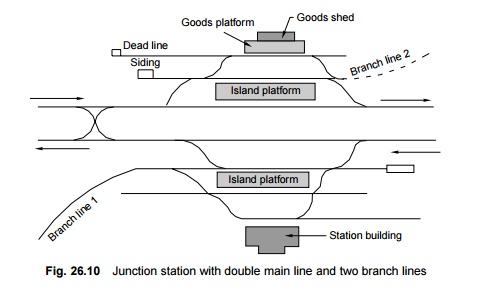
line, branch line 1, and branch
line 2. Most of the facilities provided at this station are almost the same as
described for the layout shown in Fig. 26.9.
Terminal station
The
station at which a railway line or one of its branches terminates is known as a
terminal station or a terminal junction (Fig. 26.11). The reception line
terminates in a dead end and there is provision for the engine of an incoming
train to turn around and move from the front to the rear of the train at such a
station. In addition, a terminal station may need to be equipped with
facilities for watering, cleaning, coaling, fuelling, and stabling the engines;
storing, inspecting, washing and charging the carriages; and such other works.

On unimportant branch lines, the
terminal station will have only one platform, but there are big terminal
stations such as the Howrah and Mumbai stations, which are provided with
elaborate facilities. The general layout of a big terminal station is shown in
Fig. 26.12.
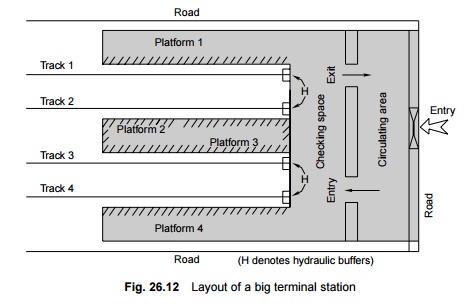
It may be noticed that access
from one platform to another is via a concourse and that there are no
overbridges provided for this purpose.
Grand Central Station at New York
Figure
26.13 depicts the circular loop provided at the Grand Central Station,
New York. The provision of circular loops enables the trains to pass through a
terminal station without any delay. A further advantage attached to the loop
system is that it enables the provision of special stations for dealing with
suburban traffic at underground locations away from the congested area of the
main terminal and in close proximity to business districts, thus affording
direct connections with other stations.
Related Topics